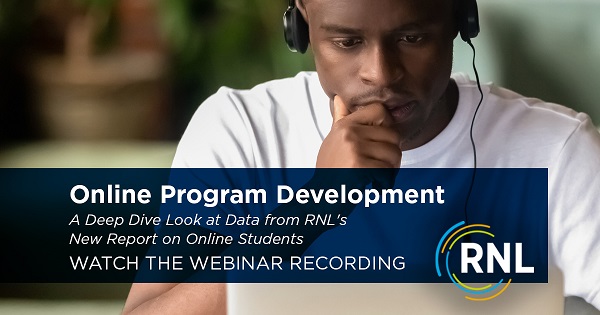enrollment
RNL’s Online Student Survey Provides Critical Information for Program Development
While several webinars this spring and summer have focused on the guidance that our Online Student Recruitment Report provides institutions on how to shape their marketing and recruitment strategies, our most recent webinar focused on how institutions must shape the online programs themselves in order to ensure that they meet student expectations.
Given that online students are not restricted by geography, their level of choice will increase even further as even more institutions leverage data like that surfaced among our sample to create online programs that are both academically sound and configured in a way that online students prefer.
It was on this specific meeting point—high quality and market responsive—on which two of my colleagues recently focused during our Online Program Development: A Deep Dive Look at Student Preference Data webinar. Both Cherron Hoppes, RNL’s chief academic officer, and Holly Tapper, vice president for graduate and online partnerships, championed academic quality and a sensitivity to nontraditional needs at multiple institutions prior to joining RNL’s graduate and online team.
Watch this 3-minute recap of the webinar with Cherron Hoppes and Holly Tapper.
Seven elements of the foundation for success
1. Biggest Opportunity
The biggest opportunity for expansion is at the bachelor’s level. Bachelor’s seekers comprised 34 percent of our sample, but prior to the pandemic comprised less than 15 percent of the total bachelor’s market. Institutions that can create high quality online bachelor’s degrees—and getting faculty on board to do so—will benefit in a way that other institutions will not.
2. Offering Online Bachelor’s
Institutions that create online bachelor’s programs using a traditional adult student degree completion approach—age minimums, 60-credit thresholds, etc.—will not “win” the student. More than 30 percent of bachelor’s seekers are under age 25, and the average number of credits they bring at admission is closer to 30 than 60. Institutions have to stretch themselves to ensure that their general education/core courses are online. This will benefit the online student, but it will also ensure that students enrolled in the traditional program can take online courses during summers, if they fall ill, and other things that in the past forced course taking at other institutions.
3. An Online Core
Developing an online “core” can be a lot less complicated than that for the traditional undergraduate population. Why? Because online students are less likely to want to a lot of options and are more likely to just take what comes next—as long as the courses demonstrate career relevance. As you develop the core and major courses, think strategically about how the same course could also be applied to multiple majors or concentrations.
4. Business Concentrations
If you are wondering if your online business programs should or should not offer concentrations, the data are clear: you will be far more likely to succeed if your BBA or MBA offers concentrations. More than 90 percent of both online bachelor’s and master’s students plan to select a concentration.
5. The Foundations for Scaling
There are four things that the most successful institutions in the online space share: the centrality of prior learning assessment (rather than being a benefit buried on a website), clear and generous prior credit acceptance policies, systems in place that allow each student to have a clear degree plan that extends from the first term to graduation, and student support systems that are focused on persistence and completion. While many institutional stakeholders focused on either revenue or academic “rigor” advocate for less credit transfer and less PLA, the benefits of generosity in these areas has more than paid off for the most successful institutions in the online space.
6. No Silver Bullet
There was a time when institutions that wanted to be sure an online programs would succeed could select among a handful of disciplines (business, health care, education, etc.) and know that there was robust demand. This is no longer the case, while business programs have held their own, and health care has seen growth (while education has seen contraction), many other disciplines have demonstrated increased demand. Institutions should not shy away from the high volume disciplines but must realize that success in penetrating that degree market is more likely in programs that align with both institutional mission and the demands of students than programs that seek to focus on some very unique aspect of the discipline (in an attempt to differentiate in the market).
7. Accelerate and Stack
While some institutions may be able to succeed in the online space while offering courses at semester lengths, their success will be limited. Only about one-third of online undergraduate students and 20 percent of online graduate students plan to enroll in a program offering semester-length courses. At both levels, they most frequently plan to take two courses at a time. So, institutions can limit their attractiveness to about one-third of the online market—and make their students take twice as long to complete their studies—or they can work on how to ensure that accelerated, stackable courses are of the highest possible quality, have appropriate learning objectives, and ensure that the maximum number of students persist. We must caution, the solution is not to cram your 16-week courses into an 8-week time period. Thoughtful and intentional work is required to examine your learning outcomes to design courses that ensure those same outcomes in a model that makes sense.
Watch the full webinar, or reach out for a free consultation
You can watch the full webinar, Online Program Development: A Deep Dive Look at Data from RNL’s New Report on Online Students. I also recommend reading the Online Student Report, which contains nearly 40 findings on 10 challenges.
We are also here to help you uncover new opportunities to develop programs and maximize your enrollment. Reach out for a free consultation with one of our online enrollment experts and we’ll set up a time to talk.

